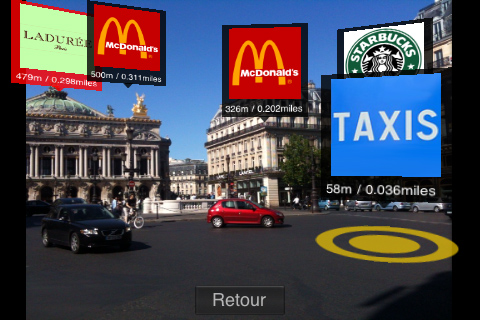 Slowly but gradually, it seems that a lot of cultural and not-for profit organisations are starting to use social media. However, some recent technological advancements could provide museums and other institutions with even more innovative ways to attract audiences and increase public participation and interactivity.
Slowly but gradually, it seems that a lot of cultural and not-for profit organisations are starting to use social media. However, some recent technological advancements could provide museums and other institutions with even more innovative ways to attract audiences and increase public participation and interactivity.
Through Web 2.0, it has become possible to extend the material environment and enhance the public’s perception of the real world. One of the developments that allows us to do this, is Augmented Reality. Augmented Reality (AR) is technical voodoo that allows you to view virtual objects in real space. It is all about adding digital and virtual images to the touchable reality. Its goal is, in a way, to search for the seamless interface between man, machine and reality.
Recently, AR has been incorporated by The Gorillaz for their album, “Plastic Beach”. The album is promoted in an edition of NME Magazine, which comes with an A5 booklet filled with Gorillaz information and an Augmented Reality marker. When this marker is held up to a webcam, the user is presented with a 3D “Plastic Beach” which can be navigated around.
Google on the other hand put an already infamous video online where they show their views and applications of Augmented Reality. As can be seen by clicking on this link, Google hopes to be able to use special glasses instead of webcams to achieve its goals.

BBC and National Geographic have also started to implement AR by using a tool called Appshaker. By wielding this AR technique in shopping malls, audiences are given the opportunity to see polar bears, penguins, and even dinosaurs come to life before their very eyes.

Clearly this kind of immersive technology is great for learning and increasing awareness and participation. Of course, because AR is in its early stages, it is hard to predict if the concept will live up to its expectations. But, there is no harm in examining the possibilities and challenges that this new concept could offer the cultural sector.

James May, best known from the BBC’s Top Gear program, teamed up with publishers ICN supported by Digitcave for 3D capture & rendering and Qualcomm, and produced an exciting new app. This app helps publics engage with exhibits in the “Making of the World” gallery at the Science Museum in London. By clicking on a marker at selected plinths, a 3D walking talking image of James May appears magically on your smartphone screen to talk to you about the objects, their functions and their history.
 Recently, the Anne Frank Organisation launched the smartphone app “Annes Amsterdam.” This app allows audiences to view images related to Anne Frank during the Second World War, in present day Amsterdam. At different locations in the city, thirty items can be viewed, which truly submerge the public into the past and present of Amsterdam.
Recently, the Anne Frank Organisation launched the smartphone app “Annes Amsterdam.” This app allows audiences to view images related to Anne Frank during the Second World War, in present day Amsterdam. At different locations in the city, thirty items can be viewed, which truly submerge the public into the past and present of Amsterdam.
In the Sukiennice Art Museum in Krakow, Poland, paintings have been brought to life thanks to the ‘New Sukiennice’ app. This app displays characters on your phone next to paintings. These characters are actors portraying the artists or the characters in the painting. These fun video and audio recreations really allows the art to come to life in the palm of your hand.
 The Virginia Museum of Fine Arts, in coordination with the Martin Agency, launched a brilliant campaign bringing together QR and AR. The musem has set up areas in multiple cities to act as virtual museums. Places like vacant lots or the streets of SoHo, have been transformed into art galleries using QR codes that launch the AR app that “places” the art “on the wall” of your smartphone. Now people in New York, Philadelphia and Washington, D.C. get to enjoy this exhibition as they walk down the streets of their city.
The Virginia Museum of Fine Arts, in coordination with the Martin Agency, launched a brilliant campaign bringing together QR and AR. The musem has set up areas in multiple cities to act as virtual museums. Places like vacant lots or the streets of SoHo, have been transformed into art galleries using QR codes that launch the AR app that “places” the art “on the wall” of your smartphone. Now people in New York, Philadelphia and Washington, D.C. get to enjoy this exhibition as they walk down the streets of their city.
Clearly the mixing of realities could literally open a new world for culture lovers, as AR allows anything from paintings to objects and animals to come to life. Furthermore, by combining the personal experience of AR with social media applications, a public relation practitioner for a museum could engage with every person individually as the displays would only be perceived by a single user, which raises the possibility of creating rich, personal experiences for all occupants of a shared space. Of course, this might cause some issues concerning privacy of data and so on. Unfortunately, many of the current AR projects are more about creating awareness, than about truly informing, teaching or inspiring the audience in a more in depth way. Most of the AR projects lack strategy, and subsequently fail to create a lasting relationship with publics. After the novelty of the AR project wears off and the public curiosity is sated, it’s uncertain if the new museum visitors will become regular visitors, members or advocates of the museum.
Never the less, personally, I do consider AR as a dream come true for the cultural industry. However, I have to stress that AR is no substitute for close observation of objects or paintings in museums or sites themselves. I still believe that only “touchable”, priceless artefacts can convey the true beauty and power contained in paintings and historical objects. For example: Why do people still flock to the Louvre to see the Mona Lisa when they can Google it for free?
I consider AR and virtual art as a viable option for people who cannot experience exhibitions in “real” life, and I do think that AR definitely provides added value and a heightened experience to existing exhibitions, but, it’s just not the same without the real thing in front of me. I like to go see theatre performances, concerts or ballet on screen in the cinema if I’m unable to attend a life performance, but, honestly, nothing can replace the experience of being in the same room as the artists, objects or paintings, and having all your senses being inspired by them. However, AR might be a step towards placing culture back into the centre of society, and might provide a way to reach out to the public in way never seen before. After all, it would be a crime if all that beauty and truth that art, history and culture have to offer us, can only be viewed by a select few in society. Considering that the cultural industry has always been a main component for evolutions in society, being deprived of the experience of being submerged in it, would therefore be, truly, a crying shame.
That is why the public’s experiences online should be just as exciting as those onsite, and both should encourage participation, openness, innovation, engagement, interaction and two-way communication. This would create better and more trustworthy and sustainable relationships, while increasing the awareness level of a cultural organisation by offering an extra service and enhancing its reputation.
